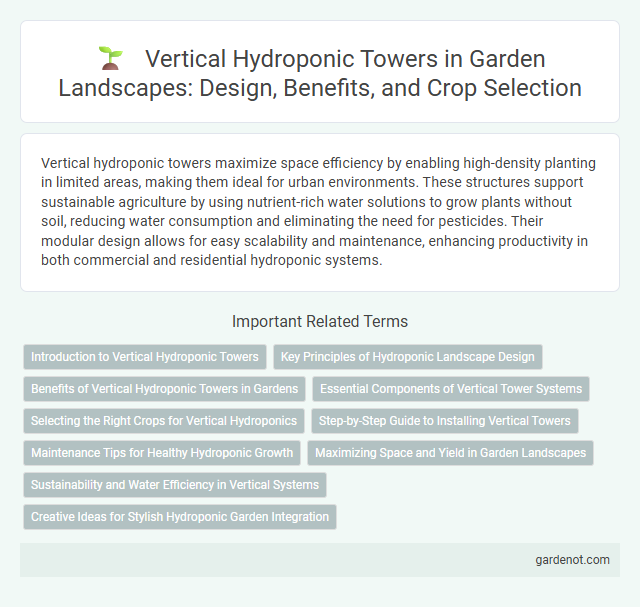Vertical hydroponic towers maximize space efficiency by enabling high-density planting in limited areas, making them ideal for urban environments. These structures support sustainable agriculture by using nutrient-rich water solutions to grow plants without soil, reducing water consumption and eliminating the need for pesticides. Their modular design allows for easy scalability and maintenance, enhancing productivity in both commercial and residential hydroponic systems.
Introduction to Vertical Hydroponic Towers
Vertical hydroponic towers revolutionize urban farming by maximizing space efficiency and crop yield through a stacked, soil-free cultivation system. These towers utilize nutrient-rich water circulated through multiple growing panels, enabling plants to grow vertically in a controlled environment. This method significantly reduces water usage and supports sustainable agriculture in limited spaces.
Key Principles of Hydroponic Landscape Design
Vertical hydroponic towers maximize space efficiency by utilizing stacked plant beds that optimize light exposure and nutrient delivery through precise water circulation systems. Key principles include selecting durable materials, ensuring structural stability, implementing automated irrigation with recirculating nutrient solutions, and integrating proper air circulation to prevent mold and promote healthy root growth. Efficient vertical hydroponic landscapes also focus on crop selection suited for vertical growth, modular design for scalability, and easy maintenance access to sustain peak productivity.
Benefits of Vertical Hydroponic Towers in Gardens
Vertical hydroponic towers maximize garden space by enabling plants to grow upward, making them ideal for small or urban environments. These towers improve water efficiency by recirculating nutrient solutions, reducing waste compared to traditional soil gardening. Enhanced air circulation around plants in vertical towers promotes healthier growth and higher yields.
Essential Components of Vertical Tower Systems
Vertical hydroponic tower systems consist of essential components such as a sturdy tower structure, a water reservoir, and an efficient nutrient delivery system. Integrated pumps circulate nutrient-rich water from the reservoir through the vertical channels, ensuring optimal hydration and nutrient absorption for each plant. Additionally, a grow medium within the tower supports root stability, maximizing space and promoting healthy plant growth in limited areas.
Selecting the Right Crops for Vertical Hydroponics
Selecting the right crops for vertical hydroponic towers involves prioritizing plants with shallow root systems and compact growth habits, such as leafy greens, herbs, and strawberries. Fast-growing varieties like lettuce, basil, and spinach maximize space efficiency and yield in vertical setups designed for optimal nutrient and water delivery. Understanding crop nutrient requirements and light preferences ensures healthy growth and sustainable production in vertical hydroponic systems.
Step-by-Step Guide to Installing Vertical Towers
Installing a vertical hydroponic tower begins with selecting a stable location that receives adequate natural light or is compatible with grow lights. Assemble the tower components by securely attaching the vertical columns and connecting the water circulation system, ensuring leak-proof seals and proper pump installation for consistent nutrient distribution. Finally, configure the growing medium within each planting site, monitor water pH and nutrient levels regularly, and plant seedlings or seeds suited for vertical hydroponic growth to optimize yield and system efficiency.
Maintenance Tips for Healthy Hydroponic Growth
Regularly inspect vertical hydroponic towers for clogs or root overgrowth to ensure optimal nutrient flow and oxygen availability. Maintain pH levels between 5.5 and 6.5 and check electrical conductivity (EC) daily to promote healthy nutrient absorption. Clean pumps and replace nutrient solutions every two weeks to prevent algae buildup and pathogen development.
Maximizing Space and Yield in Garden Landscapes
Vertical hydroponic towers optimize garden landscapes by enabling the cultivation of a high density of plants within minimal floor space, effectively transforming small areas into productive green walls. These structures use nutrient-rich water circulation systems to promote faster plant growth and higher yields compared to traditional soil gardening. By integrating vertical hydroponic towers, gardeners can achieve efficient resource use while enhancing aesthetic appeal and maximizing crop output.
Sustainability and Water Efficiency in Vertical Systems
Vertical hydroponic towers maximize sustainability by reducing soil use and enabling high-density plant growth in compact urban spaces. These systems optimize water efficiency through closed-loop recycling, minimizing water waste compared to traditional agriculture. Advanced nutrient delivery ensures precise resource management, supporting year-round crop production with significantly lower environmental impact.
Creative Ideas for Stylish Hydroponic Garden Integration
Vertical hydroponic towers maximize space efficiency while creating striking visual appeal in modern gardens. Incorporating modular designs with customizable LED grow lights enhances plant growth and adds a futuristic ambiance. Utilizing recycled materials for tower construction promotes sustainability and complements eco-friendly interior or exterior landscapes.
Vertical hydroponic tower Infographic

 gardenot.com
gardenot.com